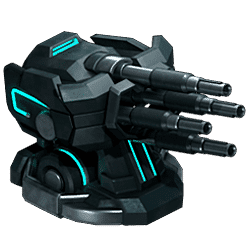Taking One Last Crack at Refitting the Mono Fleet
By: George Argyropoulos
a/k/a Dragon_Bane
As many players have noted, we have had a little bit of a tumultuous raid series. We have seen the Charged Armors and the Gridiron Monolith have their fundamental mechanics changed. The Monolith and the Combat Mortar O/U-10 get buffs and now we have a new mortar that has been introduced in the Forsaken Mission.
Things do seem to be settling down, so I think it's safe-ish to do an article for the Monolith fleet. After looking at the new mortar and the targets we saw in the last Raid, I have come up with this build (LINK):
Keep in mind, the fleet build is designed so that I can be lazy and stack the fleet when I drive. As you can see I have opted to refit to the new mortars. There are a few reasons for this:
- The D85-D has a higher DPS.
- It allows me to squeeze on another mortar overall in the build.
- It increases my overall splash.
The armors are all charged armors. This allows me to maximize damage potential on the hull due to the weight savings associated with these armors in addition to the benefits they provide with regard to damage mitigation and no repair.
The specials have been selected based on what we saw in the last raid. Reactive Armor 3 seemed to perform better overall in the targets, particularly when you avoided the Cold Snap turrets.
I used High Velocity Rounds and Combustion System 2 to increase my projectile speed and add a little spread to take advantage of the splash mechanic (see this article for more info).
The Hydraulic Resistors can be replaced with Speed System 5, I just keep using the Hydraulic Resistors out of habit. Bad pirate!
The one special that I am torn about is the Explosive Upgrade. I am torn between its use and Splash upgrade. Both fit in this design and I may change that special out if the new S target necessitates it.
I posted this build on the TFC page earlier to give players that drove stacked an option to look at and it engendered some good discussion. I'll address some of the questions that came up there below.
Q: Why don't you use X build instead?
A: There are some solid options out there. This is not the be all end all of design, it's just mine. I designed this for minimum refit time from what I had from last raid while trying to maximize the damage output. I also designed this to run with a Gridiron Monolith and not a Zelos, though I do also have a Zelos tank built. Part of this build was to cram as many of the new mortar as possible onto the build, as maximizing damage and DPS seemed to be key in mitigating overall damage to your fleet in the last raid.
Again, a lot of this particular design is the understanding that I am driving stacked. There are a good number of solid builds for the Monolith out there. Choose the one that you think will fit your driving style and abilities.
Q: Why does X build give more DPS in Huggy's?
A: I'm not sure how Huggy's calculates DPS for mortars, but I used my own calculations of DPS in conjunction with the calculations Brian and I produced in the article linked above. In Huggy's the more splash you have the higher the DPS, however, as you can see from the article, this method does not translate well into actual game play. Another thing to consider is to pop over to fleet view and see how each design stacks up with overall fleet damage. Sometimes you may get one or two hulls in a fleet to get outrageous numbers only to find that the fleet under-performs another design when looking at the big picture.
Q: Why aren't you using Tridents? You had them on your Icebreaker build.
A: The use of Tridents was to mitigate the Cold Snaps as we saw them in the Preview Servers. The turrets changed in the first iteration of the raid essentially negating their use. With this fleet, if you drive properly, you will not get hit by the Cold Snaps so you will not need the Tridents. This is also why I am using Reactive Armor 3.
Q: My O/U-10 Mono fleet did well last raid, why the switch?
A: Mine did as well, however, I am a lazy pirate and I think the loss of a month of refit time will translate into an easier time for me in the new FM targets which we will see after the next raid. If this refit makes the FM easier for me for the next year to come it will have been time well invested. It is a gamble, but so are a lot of builds.
Q: Can I use a Zelos as a tank? Is it better?
A: Of course you can, you just have to adjust your driving. As for 'better'... numbers-wise it would seem so. The Duality Countermeasure also can fire at a single missile more than once so long as that missile has not been fired upon by another countermeasure. Looking at the performances from last raid, the end results were very similar with either tank. I believe a lot of this decision will fall to personal preference, driving style and driving skill.
Q: Why are you armoring the Monoliths?
A: I am not driving them traditionally as a tank and back line, I am driving them fully stacked. As such, the stacking mechanic is dubious in the game and necessitates some measures to be taken to mitigate damage when the fleets drift out of stack.
Q: Is the Spread and Splash enough to kill adjacent turrets?
A: The only cluster I had issue with was the bottom cluster in the 100. A pinch solved that problem for me. Will that be better with this build? I'm not sure. It is one of the reasons I am torn between Explosive Upgrade and Splash Upgrade in that last special slot. We also have not seen the second S target and that may play a significant role in this decision. Here is a run in the 100 last raid with the O/U build:
Q: What if I don't have charged armors?
A: This one is tricky. You will have to adjust the build in order to fit traditional armors. This will reduce the efficiency of the build, but I think it can still be done with some acceptable numbers. It is the one drawback of the change to the Charged Armors that I do not like in that, it seems that, not having the armors puts players at a disadvantage rather than players with the armor gaining a 'luxury' advantage. Maybe this perception is derived from the perception that the targets are designed around having the charged armors - and that is merely our opinions, we don't know that for a fact, so this perception is compounded by assumption... see where that leads?
As for a build? This one seems to work very well, though the Zelos has been testing better.
So, I hope this helps some people in deciding if they want to refit, what they want to look at if they do decide to refit and maybe spur some ideas in others. I hope it helps!










































